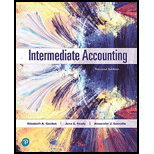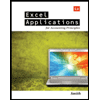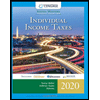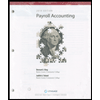
Intermediate Accounting (2nd Edition)
2nd Edition
ISBN: 9780134730370
Author: Elizabeth A. Gordon, Jana S. Raedy, Alexander J. Sannella
Publisher: PEARSON
expand_more
expand_more
format_list_bulleted
Concept explainers
Question
Chapter 17, Problem 17.7E
a.
To determine
To prepare:
Given information:
Amount collected in advance is $160,000.
Advance orders delivered amounted to $48,000.
Insurance premium paid amounted to $15,000.
Income before insurance expense and delivered groceries is $800,000.
Tax rate is 40%.
b.
To determine
To prepare: Footnote to reconcile company’s federal income tax rate to its effective tax rate.
Expert Solution & Answer
Want to see the full answer?
Check out a sample textbook solution
Students have asked these similar questions
1) Identify whethere the company is paying out dividends based on the attached statement.
2) Describe in detail how that the company’s dividend payouts have changed over the past five years.
3)Describe in detail the changes in “total equity” (representing the current “book value” of the company).
Which is not an objective of internal controls?A. Safeguard assetsB. Improve profitsC. Ensure accurate recordsD. Promote operational efficiencyneed help
Which is not an objective of internal controls?A. Safeguard assetsB. Improve profitsC. Ensure accurate recordsD. Promote operational efficiencyno ai
Chapter 17 Solutions
Intermediate Accounting (2nd Edition)
Ch. 17 - Prob. 17.1QCh. 17 - When will income tax expense and income taxes...Ch. 17 - Will permanent differences cause the effective tax...Ch. 17 - When do permanent differences arise?Ch. 17 - How are deferred tax assets and deferred tax...Ch. 17 - Prob. 17.6QCh. 17 - Prob. 17.7QCh. 17 - Prob. 17.8QCh. 17 - Prob. 17.9QCh. 17 - How does a firm determine the need for a valuation...
Ch. 17 - Prob. 17.11QCh. 17 - Prob. 17.12QCh. 17 - Prob. 17.13QCh. 17 - How does an entity account for uncertain tax...Ch. 17 - Prob. 17.15QCh. 17 - Prob. 17.16QCh. 17 - Do U.S. GAAP and IFRS classify deferred tax...Ch. 17 - Prob. 17.18QCh. 17 - Cavan Company prepared the following...Ch. 17 - Prob. 17.2MCCh. 17 - Prob. 17.3MCCh. 17 - Prob. 17.4MCCh. 17 - Prob. 17.5MCCh. 17 - Prob. 17.6MCCh. 17 - Prob. 17.7MCCh. 17 - Prob. 17.1BECh. 17 - Income Taxes Payable. Limmox Company has...Ch. 17 - Permanent Differences. Simmox Company's income...Ch. 17 - Permanent Differences. Plimmox Company's income...Ch. 17 - Permanent Differences, Reconciliation of Statutory...Ch. 17 - Prob. 17.6BECh. 17 - Prob. 17.7BECh. 17 - Prob. 17.8BECh. 17 - Prob. 17.9BECh. 17 - Prob. 17.10BECh. 17 - Temporary Differences, Deferred Tax Liability....Ch. 17 - Temporary Differences. Deferred Tax Asset....Ch. 17 - Temporary Differences, Deferred Tax Asset. Using...Ch. 17 - Prob. 17.14BECh. 17 - Realizability of Deferred Assets. Maves, Inc....Ch. 17 - Prob. 17.16BECh. 17 - Change in Tax Rates. Finer Shoes Company recorded...Ch. 17 - Change in Tax Rates, IFRS. Use the same...Ch. 17 - Prob. 17.19BECh. 17 - Prob. 17.20BECh. 17 - Prob. 17.21BECh. 17 - Prob. 17.22BECh. 17 - Prob. 17.23BECh. 17 - Prob. 17.24BECh. 17 - Prob. 17.25BECh. 17 - Prob. 17.1ECh. 17 - Prob. 17.2ECh. 17 - Prob. 17.3ECh. 17 - Prob. 17.4ECh. 17 - Temporary Differences, Deferred Tax Assets and...Ch. 17 - Temporary Differences, Deferred Tax Assets and...Ch. 17 - Prob. 17.7ECh. 17 - Prob. 17.8ECh. 17 - Change in Tax Rates, Permanent Difference,...Ch. 17 - Prob. 17.10ECh. 17 - Prob. 17.11ECh. 17 - Net Operating Loss, Carryback. Phlash Photo Labs,...Ch. 17 - Net Operating Loss, Carryforward. Loggins Lumber...Ch. 17 - Prob. 17.14ECh. 17 - Prob. 17.15ECh. 17 - Net Operating Loss, Carryforward, Tax Rate Change....Ch. 17 - Prob. 17.17ECh. 17 - Prob. 17.18ECh. 17 - Uncertain Tax Positions. Lewis Eagle Corporation...Ch. 17 - Uncertain Tax Positions. Based on the information...Ch. 17 - Prob. 17.1PCh. 17 - Temporary Differences, Deferred Tax Liabilities,...Ch. 17 - Temporary Differences, Deferred Tax Liabilities....Ch. 17 - Prob. 17.4PCh. 17 - Temporary Differences, Deferred Tax Liabilities,...Ch. 17 - Prob. 17.6PCh. 17 - Net Operating Loss, Carryback, Carryforward,...Ch. 17 - Prob. 17.8PCh. 17 - Net Operating Loss, Carryback. Carryforward. CPF...Ch. 17 - Prob. 17.10PCh. 17 - Prob. 17.11PCh. 17 - Prob. 17.12PCh. 17 - Permanent Differences, Temporary Tax Differences,...Ch. 17 - Prob. 1JCCh. 17 - Prob. 2JCCh. 17 - Prob. 1FSCCh. 17 - Prob. 1SSCCh. 17 - Prob. 2SSCCh. 17 - Prob. 3SSCCh. 17 - Scene 1: The concept of the deferred tax liability...Ch. 17 - Basis for Conclusions Case 2: Uncertain Tax...
Knowledge Booster
Learn more about
Need a deep-dive on the concept behind this application? Look no further. Learn more about this topic, accounting and related others by exploring similar questions and additional content below.Similar questions
- Can you solve this general accounting problem using appropriate accounting principles?arrow_forwardWhich is not an objective of internal controls?A. Safeguard assetsB. Improve profitsC. Ensure accurate recordsD. Promote operational efficiency no aiarrow_forwardPlease provide the accurate answer to this financial accounting problem using appropriate methods.arrow_forward
- Please provide the correct answer to this financial accounting problem using valid calculations.arrow_forward20 Nelson and Murdock, a law firm, sells $8,000,000 of four-year, 8% bonds priced to yield 6.6%. The bonds are dated January 1, 2026, but due to some regulatory hurdles are not issued until March 1, 2026. Interest is payable on January 1 and July 1 each year. The bonds sell for $8,388,175 plus accrued interest. In mid-June, Nelson and Murdock earns an unusually large fee of $11,000,000 for one of its cases. They use part of the proceeds to buy back the bonds in the open market on July 1, 2026 after the interest payment has been made. Nelson and Murdock pays a total of $8,456,234 to reacquire the bonds and retires them. Required1. The issuance of the bonds—assume that Nelson and Murdock has adopted a policy of crediting interest expense for the accrued interest on the date of sale.2. Payment of interest and related amortization on July 1, 2026.3. Reacquisition and retirement of the bonds.arrow_forward13 Which of the following is correct about the difference between basic earnings per share (EPS) and diluted earnings per share? Question 13 options: Basic EPS uses comprehensive income in its calculation, whereas diluted EPS does not. Basic EPS is not a required disclosure, whereas diluted EPS is required disclosure. Basic EPS uses total common shares outstanding, whereas diluted EPS uses the weighted-average number of common shares. Basic EPS is not adjusted for the potential dilutive effects of complex financial structures, whereas diluted EPS is adjusted.arrow_forward
arrow_back_ios
SEE MORE QUESTIONS
arrow_forward_ios
Recommended textbooks for you
 Excel Applications for Accounting PrinciplesAccountingISBN:9781111581565Author:Gaylord N. SmithPublisher:Cengage Learning
Excel Applications for Accounting PrinciplesAccountingISBN:9781111581565Author:Gaylord N. SmithPublisher:Cengage Learning Individual Income TaxesAccountingISBN:9780357109731Author:HoffmanPublisher:CENGAGE LEARNING - CONSIGNMENT
Individual Income TaxesAccountingISBN:9780357109731Author:HoffmanPublisher:CENGAGE LEARNING - CONSIGNMENT
 Intermediate Accounting: Reporting And AnalysisAccountingISBN:9781337788281Author:James M. Wahlen, Jefferson P. Jones, Donald PagachPublisher:Cengage Learning
Intermediate Accounting: Reporting And AnalysisAccountingISBN:9781337788281Author:James M. Wahlen, Jefferson P. Jones, Donald PagachPublisher:Cengage Learning

Excel Applications for Accounting Principles
Accounting
ISBN:9781111581565
Author:Gaylord N. Smith
Publisher:Cengage Learning



Individual Income Taxes
Accounting
ISBN:9780357109731
Author:Hoffman
Publisher:CENGAGE LEARNING - CONSIGNMENT


Intermediate Accounting: Reporting And Analysis
Accounting
ISBN:9781337788281
Author:James M. Wahlen, Jefferson P. Jones, Donald Pagach
Publisher:Cengage Learning
Chapter 19 Accounting for Income Taxes Part 1; Author: Vicki Stewart;https://www.youtube.com/watch?v=FMjwcdZhLoE;License: Standard Youtube License